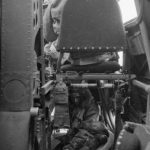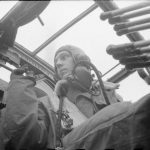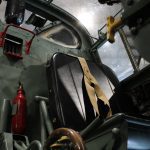On a September afternoon in 1997, a group of men set to work exhuming a grave. Knee-deep in the mud of a Belgian bog, they sifted through the remains of downed World War Two-era bomber, trying to uncover the story of the plane and its lost crew.
Karl Kjarsgaard headed the operation. As director of Halifax 57 Canada, an aircraft recovery group focused on Handley Page Halifaxes, he often receives tips about their location, whether that be in English fields, the Irish Sea, or in this case, six metres under the mud.
The recovery of the plane, a Royal Canadian Air Force (RCAF) bomber stamped with the serial number LW682 at the time of its manufacture, had been a salvage operation. The crew knew they weren’t going to find a whole plane, but were still optimistic that some parts would be in useable condition. It was the second project that Halifax 57, the Canadian branch of an English group, had ever accomplished. They had pulled another downed Halifax from a lake in Norway just two years earlier and were looking for parts to contribute to its rebuilding. So when Kjarsgaard was approached by the family members of three of the plane’s Canadian crew, asking him to bring them to the surface, he readily accepted.
The plane had been reduced to scrap metal after it had crashed in 1943, but the team crowded around it as it was released from decades deep in the earth were still hopeful their efforts hadn’t been entirely for naught.
Not much of it was left and what was wouldn’t be enough to significantly contribute to the rebuild.
Despite the condition of the plane, LW682 held a remarkable number of still-intact personal effects, such as parts of uniform tunics and watch casings. One of the nearby town’s residents, who had recovered an axe from the crash site as a boy, approached the recovery team to return it.
The group adhered to the old adage that had been the mantra of Second World War aircrews— “We press on regardless.” The focus shifted entirely on recovering the remains of the crew members. Back in Canada, three families waited to hear whether the long-MIA men could become war dead, receive a proper burial and finally have their stories come to a close.
Kjarsgaard always makes sure to call before he digs—before he secures permission from foreign governments, he has it from the families. With permission from their descendents, the men’s bodies were recovered and given a proper military burial by the Belgian government.
“We dug up the entire airplane and we found the three guys inside,” Kjarsgaard says. “It’s one thing to have a guy missing in action. It’s another thing where someone says to you, ‘My uncle’s buried here.’ So we gave them back.”
When aircrew are no longer around to tell their stories, it falls on the objects they used, their planes included, to serve as reminders of their time in combat. This motivates groups like Halifax 57 to dig through the wreckage. “It gives you a goal, pulling that stuff up,” says Scott Knox, an engineer with Halifax 57. “The prime objective here is, not only are you digging up an aircraft, but you are dusting off these stories that may not have ever been told.”
Canada has approximately 50,000 remaining World War Two veterans—as they die, their first-hand-accounts are being lost. Those lost during the war were never able to share their stories. Many who returned to Canada are unwilling to relive their wartime experiences as a result of “combat fatigue” (the common term for post-traumatic stress disorder at the time).
Bomber Command, the RCAF group in control of English and Canadian bombing operations, had some of the highest casualty rates of the war. Of the 120,000 enlisted airmen, 55,573 were killed, including more than 10,000 Canadians. It becomes the work of museums to keep what stories have been shared alive—either via first-hand accounts or through the physical artifacts of combat.
But another group of dedicated individuals—some former air force members, others the children of veterans—have taken it upon themselves to preserve the history of the “bomber boys” via the grandest gesture possible: recovering the aircraft they flew in.
Halifax 57 is one such group, focused on unearthing the bombing aircraft heavily used by Canadians during the war and educating the public about them.
Every part of the Halifax bomber has a manufacturing serial number with the prefix 57—the group includes the number in its title because it represents its goal of unifying all of the aircraft’s pieces.
Seventy per cent of all Canadian aircrew who saw combat did so in the belly of a Halifax. The Halifax’s “underdog” status as a bomber when compared to the Avro Lancaster, a larger aircraft with a greater bomb-carrying capacity, is apparent from its lack of presence in museums. There are five restored Lancasters across Canada, including one of two in flying condition at the Warplane Heritage Museum in Hamilton, Ont. Another four are currently being restored by other museums across the country.
There is a single restored Halifax in Canada in Trenton, Ont., and one in Yorkshire, U.K., not far from the town of Halifax that the plane is named for. A final Halifax sits in London’s RAF Museum in the condition it was found in, a waterlogged skeleton. None of the 6,178 built during wartime were brought back to Canada for posterity. When Canadian airmen returned home, their Halifaxes remained in Europe, either sold for parts or scrap metal or in the grasp of whatever Norwegian lake or plot of English countryside they’d crashed into. Groups such as Halifax 57 aim to find these aircraft, make them whole again and give them a home in Canada.
It’s what keeps one small group of Halifax 57 volunteers from a town in southern Alberta motivated during their largest project to date.




